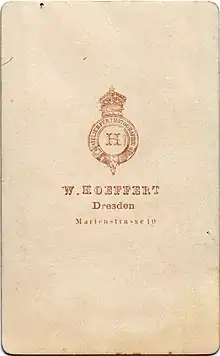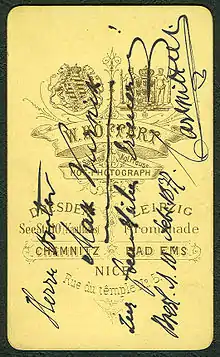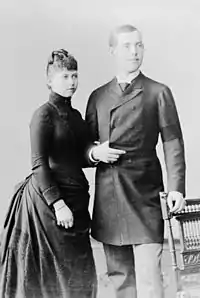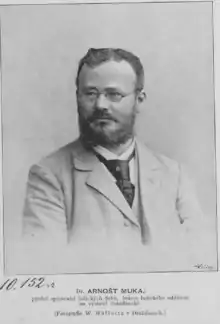Wilhelm Höffert
Ernst Friedrich Wilhelm Hugo Höffert (25 October 1832 – 8 April 1901) was a German photographer, who ran studios in numerous German cities.


Life
Höffert's parents were actors. He was born during a theatre engagement of his parents in Stralsund.[1] The mother was the actress Emilie Wilhelmine Johanna Louise Höffert (1808-1857), née Devrient, the daughter of the actor Ludwig Devrient. The father was the actor and director Wilhelm David Höffert.[2] As a child, Höffert was probably accompanied by his mother, his brother Louis and sister Elise. In 1840, she was engaged at the Grand Ducal Court Theatre in Schwerin.[3] From 1845 to 1851, she was a court actress at the Oldenburg Court Theatre.[4]
From Oldenburg, the 16-year-old Höffert went to the Kunstakademie Düsseldorf in 1848 to be taught painting by Karl Ferdinand Sohn and Theodor Hildebrandt, who introduced him in particular to portrait painting. Hildebrandt assessed his achievements with the grade "very good". In 1850, Höffert left the art academy.
Whether Höffert had in fact subsequently spent time as a photographer in Warsaw and Russia, as his mother had assumed, is not known.[5]
In 1860, he entered into a business partnership with the photographer and painter Moritz Unna in Gothenburg. Unna had opened a studio in Gothenburg in 1853 as a daguerreotypist, and from 1855, the address was Drottninggatan 68. The joint company traded as Unna & Höfferts Fotografiska Atelier with the address Södra Hamngatan 41.[1] In 1863, the partnership was dissolved and Unna went to Copenhagen, where he bought the photographic studio of Peter Ludwig Rudolph Striegler (1816-1876).
Höffert presumably returned to Germany in the same year and opened a photographic studio in Dresden under his name.[6] Höffert was one of the first photographers to become entrepreneurial, setting up photographic studios under the name "W. Höffert" in several cities and/or had them operated. The names of the operators/studio owners were in many cases not known,[7] The business relationships do not seem to have been clear. Only the photographer Georg Brokesch called himself managing director of the Leipzig studio from 1872 to 1875.
From 1872 to 1884, Höffert lived in Dresden at Pragerstaße 32 and until 1889 at Lüttichaustr. 18. According to the entry in the Dresden address books, he had given procuration to his wife Mila Höffert in 1876. [8][9] She is first listed as a co-owner in the Berlin and Dresden address books of 1895. It is not known which area of responsibility she had in particular.
In 1892, Höffert entered the US via New York. He was married a second time[10] and lived in Chicago. It is not known when he left the USA again.[11][12]
Even though a large number of photographs still exist today on which the name "W. Höffert" was printed, neither much is known about Höffert's life and whereabouts, nor how long he photographed or portrayed himself.[13]
Höffert was married to Bohumila (called Mila) Wehle. She was the daughter of the Sorbs writer Jan Wjela-Radyserb/ Johann Wehle (1822-1907).[14] From this marriage came the son Ludwig, with whom she continued the business after Höffert's death in April 1901.[15] In 1903, presumably in the summer, Mila Höffert filed for bankruptcy. In July 1904, she was tried for fraud before the Dresden District Court.[16] The son had evaded the proceedings by fleeing abroad.[17]
Höffert died in Wiesbaden at the age of 68.[18]
W. Höffert — Ateliers und Filialen
- in Dresden von 1864 bis 1877 in der Marienstraße 10, from 1874 until 1890 in the Seestraße 10'[19] in Kaufhaus Herzfeld,[20] from 1891 until 1899 in the Prager Straße 49 and from 1900 until 1903 at the house number 7.[21][22]
- in Leipzig from ca. 1869 until April 1876 in "Thomaskirchhof 24"[23] and from 15 April 1876[24] until 1905[25] in der Schlossgasse 16 im Kaufhaus August Polich[26]
- in Chemnitz from about 1872 to 1878 at Zwickauerstraße 1 im Garten[27] and from 1879 to 1893[28] with the address Langestraße 18.[29]
- in Bad Ems (start and period unknown),
- in Karlsruhe in 1875 and 1876[30] in der Hirschstraße 36.[31][32]
- in Nice in the "Rue du temple No. 5". (1876–1881)
- In Berlin, there is evidence of the studio at Leipziger Platz 12 from 1885 to 1897, and from 1892 to 1900 in Unter den Linden 24.[33][34]
- in Breslau at "Tauentzienplatz 11'"[35] (start and period unknown),
- in Hamburg from 1881 until 1899 in the Poststraße 5b/Jungfernstieg 6 (ab 1885 Jungfernstieg 12)[36]/Stadtwassermühle 5[37] and from 1900 to 1902 in the Esplanade 47, Alsterthor 14/16[38]
- in Hanover in the "Georgstraße 9", first entry in the address book's list of residents in 1879 with the note "Prok.: Ehefr. Höffert, Mila, née Wehle", from 1885 "Archit. Wilhelm Sültenfuß", from 1889 at number 14, from 1901 number 8, from 1892 "Inh. Photogr. Jul. Benade", from 1894 Wilhelm Höffert and wife Mila, from 1897 instead of the wife the son "Ing. und Photogr. Paul Ludw. Höffert", from 1902 "We.[Witwe] Mila Höffert, geb. Wehle" and son, from 1904 "Lemförderstraße 1", from 1905 "Wihelm Höffert Nachf.", Alfred von Carlowitz-Hartitzsch,
- in Magdeburg in the "Breiteweg 196/197", (start and period unknown)
- in Bonn, from 30 July 1900 to 1901[39] in the "Coblenzerstr. ",[40]
- in Düsseldorf, "Alleestraße 40", First entry in the address book (trade) of 1897. The entry "Höffert, Wilhelm Ehefr., geb. Wehle", from 1899 "Höffert, Wilhelm, Hofphotograph", later owner Julius Staegemann.
- in Cologne from 1896[41] bis ca. 1906[42] in der Hohestraße 55 (later Hohestraße 111a).
- in Potsdam, "Humboldtstr. 1", subsequent owner C. Wohlatz
On the backs of some of the photographs, Munich is still indicated as the location of the studio.
After the insolvency of W. Höffert, in some locations the operators continued the studios using the name W.[ilhelm] Höffert Nachf.[olger], for example in Leipzig the photographers E. & M. Foerstner (or Förstner) initially at Schloßgasse 1/corner of Petersbrücke, from 1906 to 1907 at the address Barfußgasse 15, in Düsseldorf[43] and in Hamburg Johann Kagel from 1903 to 1906. in "Alstertor 14/16".[44] The address book of the city of Bonn in 1903 verzeichnet den Fotografen Ferd[inand] Bauer in der Coblenzerstr. 8a als Inhaber von "W. Höffert".[45]
Known assistants and apprentices
The photographer Nicola Perscheid had been employed as a photographer's assistant in Höffert's Dresden studio in Seestrasse for two years before opening his own studio in 1891.[46]
In 1894/95, the later successful photographer Hugo Erfurth completed a one-year apprenticeship at Höffert's.[47][48]
Court photographer
- As Crown Prince, the later King Albert of Saxony Wilhelm Höffert (around 1872,[49] exact date not known) the title of Kingdom of Saxony Court pohotographer.[50]
- A few years later (date unknown), Höffert indicated by depicting the coat of arms that he had also been appointed by the Kingdom of Prussia[51] Court Photographer.
- Later (date unknown) he also depicted the coat of arms of the Prince of Wales[52] page and later King Edward VII, which identified him as a purveyor to the court for photographs.
- The fourth coat of arms shown identifies W. Höffert as a purveyor to the court of the House of Mecklenburg-Schwerin.[53]
- Prince Friedrich Leopold of Prussia.[54][55]
- Prince Maximilian of Baden.[54]
Photographs
 Princess Sophia of Prussia and the futur Constantine I of Greece (September 1888)
Princess Sophia of Prussia and the futur Constantine I of Greece (September 1888) Chancellor Leo von Caprivi (January 1890)
Chancellor Leo von Caprivi (January 1890) Actor Carl Mittell
Actor Carl Mittell_b_573.jpg.webp) Ernst Keil, founder, publisher and editor-in-chief of Die Gartenlaube
Ernst Keil, founder, publisher and editor-in-chief of Die Gartenlaube Writer Arnošt Muka (1896)
Writer Arnošt Muka (1896) Actress Agnes Sorma
Actress Agnes Sorma Actor Josef Kainz
Actor Josef Kainz The Gebrüder-Herrnfeld-Theater, actors an dramaturges (1898)
The Gebrüder-Herrnfeld-Theater, actors an dramaturges (1898) The businesswoman Agathe Zeis
The businesswoman Agathe Zeis Military bishop Johannes Maria Assmann
Military bishop Johannes Maria Assmann Opera singer Hermann Bachmann in Der Ring des Nibelungen (part of Hagen von Tronje)
Opera singer Hermann Bachmann in Der Ring des Nibelungen (part of Hagen von Tronje) Friedrich Mann, who inspired Christian Buddenbrook's character from the novel Buddenbrooks (1901) by Thomas Mann.
Friedrich Mann, who inspired Christian Buddenbrook's character from the novel Buddenbrooks (1901) by Thomas Mann.
Further reading
- Address books div. cities
- Horst Milde: Dresdner Atelier-Fotografie. Verlag der Kunst, Dresden, 1991, ISBN 3-364-00217-7.
- Christina Ossowski (Bearb.): Historische Kameras und Leipziger Photographie 1840–1950, Katalog zur gleichnamigen Ausstellung im Museum der bildenden Künste Leipzig vom 12. März bis zum 1. Mai 1983, hrsg. im Auftrag des Rates des Bezirkes Leipzig, Museum der bildenden Künste, Leipzig 1983
- Ein tüchtiger Photograph|number=1550 |date=15 March 1873 |page=204
- Jürgen Matschie (ed.): Wótmólowane – Mit Licht gemalt. Historische Fotografien in der sorbischen/wendischen Niederlausitz. Domowina-Verlag, Bautzen 2017, ISBN 978-3-7420-2419-0, Review: Christian Ruf (8 May 2017). "Ein Stück angehaltener Zeit". Heimatgeschichte. Dresdner Neueste Nachrichten. Retrieved 20 January 2021.
- Maria Mirtschin: Visuelle Identifikationen. Aspekte der Bildnisfotografie bei den Sorben vom 19. Jahrhundert bis zum Ersten Weltkrieg. Kleine Reihe des Sorbischen Instituts 22, Bautzen 2014, ISBN 978-3-9813244-9-5; Table of contents (PDF)
- Höffert, Emilie (in German), München: A. Bruckmann, 1892 1885, p. 145 Check date values in:
|date=(help)CS1 maint: date and year (link) - Joseph Kürschner (1880), "Höffert, Emilie", Allgemeine Deutsche Biographie (ADB) (in German), 12, Leipzig: Duncker & Humblot, pp. 568–569
- Anna Löhn-Siegel: Ein Bild aus dem Schauspielerleben. In Die Gartenlaube. 1885, pp. 102–103 (Volltext [Wikisource).Gartenlaube
- Die einzige Tochter Ludwig Devrient’s. In Anna Löhn-Siegel: Vom Oldenburger Hoftheater zum Dresdner. letzte Theatertagebuchblätter, Schulzesche Hof-Buchh. und Hof-Buchdr., Oldenburg 1885, pp. 53 ff., urn:nbn:de:gbv:45:1-5977:{{{2}}}, (simialar text in the Die Gartenlaube)
References
- The Almanach für Freunde der Schauspielkunst, which appeared annually over a long period of time, named a Sch.[auspieler] Höffert and a Mad.[ame] Sch.[auspielerin] Höffert as the only bearers of the name, with a few exceptions. They verifiably played (several mentions in Sundine: Unterhaltungsblatt nebst Literatur- und Intelligenz-Blatt für Neu-Vorpommern und Rügen; Jg. 1833, Wilhelm Hauschildt, Stralsund (urn:nbn:en:bvb:12-bsb10618025-0:{{{2}}} BSB)) in 1832 and 1833 at the Stralsund Theatre.
- Ladies, (Mad. Höffert). In L. Wolff (ed.): Almanach für Freunde der Schauspielkunst auf das Jahr 1840, Sittenfeld, 1841, p. 432, Numerized
- Harald Schieckel: Mitteldeutsche im Lande Oldenburg II. In Oldenburger Jahrbuch, vol. 67, 1968, p. 51 [58], urn:nbn:de:gbv:45:1-3267:{{{2}}}.
- Anna Löhn-Siegel: Die einzige Tochter Ludwig Devrient's, p. 63. (She published this statement in 1885 by Emilie Höffert, who had already died in 1857. The author Anna Löhn-Siegel had performed together with Emilie Höffert at the court theatre in Oldenburg for two years.)
- First entry "Höffert, E.F.W. Hugo, Photograph, Marienstrasse 10, pt." in the name register of the 1864 Dresden address book, (Online, SLUB).
- Indications of the names of the operators can be found, for example, in the registers for street names in the address books.
- In the name register of the Dresden address book of 1876, "Ehefr. Mila" is listed as procurator in the company W. Höffert, (Online, SLUB).
- Cited in Hanni Schwarz: Photographie als Frauenberuf. In Hermann Wilhelm Vogel (ed.): Photographische Mitteilungen. 45th Jg. Gustav Schmist, Berlin 1905, p. 162, Numerized.
- Höffert ("Wilhelm Hoffert, Dresden") was accompanied by a 30-year-old "Mrs. Wilhelm Hoffert" and a 2-year-old child "Jeta Hoffert": Ellis Island Foundation (Weblinks)
- The New York Public Library (Weblinks)
- A photograph by Helen Castle Mead (wife of George Herbert Mead, professor of Sociology at the University of Chicago.), possibly taken in Chicago photograph, (University of Chicago Library, Archival Photographic Files)
- He was also indicated as a portrait painter.
- Susanne Hose (2014-03-17). en/biografie/Johann_Wehle_(1822-1907) "Wjela (Wehle), Jan (Johann), from 1847 Jan Radyserb-Wjela (pseudonym: Žarin, Mrowjan)" Check
|url=value (help). Saxon Biography. Institut für Sächsische Geschichte und Volkskunde e. V. Retrieved 19 January 2021. - Copy of a lapel "W. Höffert Inhaber Ludwig Höffert & Mila Höffert Hofphotographograph ... H. d. Prinzen Friedr. Leopold v. Preussen, Sr. Hoh. d. Prinzen Maximilian v. Baden, Hofphotographin Sr. Majestät d. König von Sachsen & Sr. Kgl. Hoh. d. Grossherzogs v. Mecklenburg..., Hannover Georgstrasse, Dresden Leipzig Hamburg Magdeburg (Online, University of Kassel), further source: Adreßbuch der Hoflieferanten im Königreich Sachsen, 1904, Höffert, P. Ludw., Hofphotograph Königreich Preußen, zugleich Sr. Majestät des Deutschen Kaisers, Schöneberg, (also of Prince Leopold of Prussia) page 12; Höffert, M. verw. Court Photographer of the Grand Duchy of Mecklenburg-Schwerin, Dresden, page 14; Höffert, P. Ludw., Court Photographer to the King of Great Britainn, page 18; (Numerized, SLUB).
- Zur Insolvenz der Fa. W. Höffert/ Übernahme durch (Kaufhaus) Herzfeld. Photographische Kunst. 2. Süddeutschen Photographen-Vereins eV, Sitz München. 1903. pp. 80ff, 375, 404. 1091797-4. and Zum Fall Höffert. Wiener Freie Photographen-Zeitung. 6. Vienna. 1903. pp. 56–57.
- Vermischtes. In Der Photograph, 14. Jg., No. 28, Hanover, 1904, p. 111.
- see Hessisches Staatsarchiv Marburg (HStAMR), Best. 925 No. 2712, p. 396 (numerized).
- Auf den Revers einiger Fotografien ist auch Hausnummer 21 angegeben. Hierzu fanden sich bisher keine Hinweise in den Adressbüchern.
- Höffert was apparently the first to run a studio in a department store. Source Jeanne Rehnig (2004). Was ist das, ein Atelier im Warenhaus. Fotografien vom Alltag – Fotografieren als Alltag. Münster: Dr. Irene Ziehe. p. 200., (Numerized)
- Horst Milde, page 146.
- The studio was closed at the end of 1903 because it was a fire hazard. Herzfeld had acquired the studio. (source: Vermischtes. In Der Photograph, 13. Jg., No. 48, Hanover, 1903, p. 190)
- W. Höffert was first mentioned in the name register of the Leipzig address book of 1870 with the address Thomaskirchhof, (Online, SLUB). House number 24 mentioned a building (Kasternr. 567b) that had probably already been used as a photographic studio in the years before. In the directories of the following years on the street names, the photographer F.[riedrich] Manecke is initially listed as the owner, and from 1871 G.[eorg] Brokesch as the operator of a studio, and from 1875 W. Höffert was listed as the owner (Online, SLUB). G. Brokesch was from 1871 to 1875 managing director of the photograph. Atelier of W. Höffert in the address books. Later entries in the yellow pages contained the reference that it was a trading company. The Thomaskirchhof studio was owned for a few years from 1877 by a photographer "B[ohuwjer]. Wehle" (source: address books), who may have been the brother-in-law of Höffert. The lapels were titled Promenade, vis-à-vis the Centralhalle. B. Wehle betrieb auch Ateliers in Dresden und Elberfeld.
- See name register of the Leipzig address book of 1876 with address Schlossgasse 16, (Online, SLUB).
- Letzter Eintrag im Adressbuch 1905.
- In 1883, the numbering of the buildings in Schlossgasse was probably changed by putting the even numbers on one side of the street and the odd numbers on the other. Thus Schlossgasse 16 became Schlossgasse 1 in 1883, (Online,SLUB).
- For the first time W. Höffert was mentioned in the name register of the Chemnitz address book of 1872 with address Zwickauerstraße 1 im Garten, (Online, SLUB). The lapels were titled: bei der dortigen "Nicolaiapotheke".
- The last entry in the address book was in 1893.
- Presumably from 1882 Leopold Rudolph Fleck continued the business under the name W. Höffert (Online, SLUB). In 1889 Auguste Ernestine Fleck became the owner of the shop after her husband died (ref. Wwe. in the address book). In 1891 her last entry was made. Until 1891, the street directory listed house number 18 under cadastral number 155, from 1892 house number 34, where Höffert's studio had been located in a rear building (HG).
- The stay in Karlsruhe lasted only 2 years, if the information in the address books is taken as a guide. Julius Stöl(t)zner was also listed as a photographer at the address "Hirschstarsse 36" in both years (Online, BLB). In 1877 Carl Schade ran the studio.
- Rückseite, Fedor Rinck, Deutsche Fotothek
- StadtWiki Karlsruhe, (Online).
- "Wilhelm Höffert Nachf., Inhaber C. Wohlatz", in Photographische Correspondenz, 1913, p. 323.
- There is contradictory information on the dates of Prof. Dr. Sibylle Einholz (Berliner Fotografenateliers), for the last time the entry W. Höffert Photograph. Kunstanstalt with address "Unter den Linden 24" is listed in the name register in the Berlin address book of 1904 (p. 727) and in the business register in the address book of 1903. (p. 243).
- Towards the end of 1903, the Dresden bankruptcy trustee, Dr. Thürmer, wanted to sell the studio and its inventory for 12,500 Mk. No bidder was found. (source: "diverse"). In Der Photograph, 13. Jg., No. 40, Hanover, 1903, p. 158)
- From 1885, the numbering was changed. The address "Jungfernstieg 6" was then changed to No. 12, and the rear building also had the address "Poststraße 5". This was also the address of the photographer Ludwig Bernitt until 1895. Possibly he had been managing director or operator of the photographic studio of Höffert in Hamburg.
- The specification of three street names gives the impression that several studios were involved. However, this was not the case. The rear building Jungfernstieg 6 had an additional entrance from Stadtwassermühle 5. (source: Thorsten Bölck: Der "Mühlen Canal" – ein Tunnel von Hamburgs Binnenalster zum Bleichenfleet, in Christoph Ohlig (ed.): Hamburg – die Elbe und das Wasser sowie weitere wasserhistorische Beiträge from the series of publications of the Deutsche Wasserhistorische Gesellschaft (DWhG) e. V., vol. 13, BoD, Siegburg 2009, ISBN 978-3-8370-2347-3, p. 44). This studio had been used by the well-known Hamburg photographer Heinrich Friedrich Plate from 1858 to 1880
- Johann Kagel bought the studio and continues it under the existing name (source: Ateliernachrichten. In Der Photograph, 13. Jg., No. 37, Hanover, 1903, p. 146).
- Anzeige im General-Anzeiger Bonn vom 30 July 1900, p. 1, Adress book Bonn 1900–1902
- Photographen, Bonn.
- First verifiable entry in the Cologne address book. The digitally available address books for Cologne are currently not complete, among others the year 1900 is missing..
- From the 1901 edition onwards, Balthasar Blum and Caspar Ditger were additionally named. Blum was verifiable as a photographer and therefore wsh. According to an earlier entry, Ditger was a partner and innkeeper by profession. There was also a photographic studio from time to time. "Blum & Höffert".
- Probably Julius Staegemann, owner of the firm W. Höffert Nachf., Alleestrasse 40, Düsseldorf.
- Kai Deecke: Fotografen und ihre Ateliers in Hamburg von 1855 bis 1915, Erwähnungen in den Ausgaben der Hamburger Adressbücher, Selbstverlag, Hamburg, 2012.
- p. 196, compare the results of the Verein für Computergenealogie.
- Katja Schumann: Nicola Perscheid (1864-1930). Forschungen zu einem Berufsphotographen im Kontext der Kunstphotographie um 1900, (the results of her master's thesis presented at the TU Dresden 2003). Lecture (on the occasion of the Hermann Krone Prize Award 2004, on 27 September 2004), [abridged version], (Online).
- Photographische Correspondenz, 47. Jg., 1910, p. 545.
- Bodo von Dewitz, Karin Schuller-Procopovici (ed.): Hugo Erfurth, 1874–1948. Photograph zwischen Tradition und Moderne. Wienand, Cologne 1992, ISBN 3-87909-312-1
- first mentioned in the name register of the Dresden Address Book of 1873, the title Court Photographer H.K.H. d. Kronprinzen Albert, (Online, SLUB).
- "Awarding of Court Predicates". Ministry of the Royal House. Saxon State Archives. Retrieved 20 January 2021.
- For this purpose, W. Höffert will presumably have stayed in the/his Berlin studio several times and over a longer period of time
- Compare the image of the Lapel with three coats of arms and transcription on the GenWiki
- Among the 15 photographs, by Höffert in the possession of the Theatermuseum Meiningen (i.e. "Zauberwelt der Kulisse") is one in the cabinet card with a portrait of the actor Josef Kainz depicting all four coats of arms(Online, Museum Digital Thüringen).
- Address books of Hanover, Einwohnerverzeichnis
- In the Berlin address books of 1895.
External links
- Literature by and about Wilhelm Höffert in the German National Library catalogue
| Wikimedia Commons has media related to Wilhelm Höffert. |
| Wikisource has original text related to this article: |
| Wikisource has original text related to this article: |
- "Wilhelm Höffert". europeana collections.
- "Höffert, Wilhelm". Archiv der Fotografen. Deutsche Fotothek.
- "Unna & Höfferts". Faktabanken (Göteborg) (in Northern Sami). Sveriges Släktforskarförbund.
- Max Hochstetler. "Wilhelm Höffert". Photographers. Luminous-Lint.com.
- "Wilhelm Höffert German, 1832–1901". Photographers’ Identities Catalog. The New York Public Library. Im Gegensatz zu den hier gemachten Angaben hieß das niederländische Schiff „Dubbeldam“. Ausgangshafen war wahrscheinlich Amsterdam. Nach Angaben der Ellis Island Foundation reiste Höffert mit einer 30-jährigen „Mrs. Wilhelm Hoffert“ ein.
- "Gästeliste Louisenstraße 89, Hauptgebäude". Digitales Gebäudebuch Bad Homburg. Landesgeschichtliches Informationssystem Hesse. Höffert hielt sich von Januar bis Juni 1872 in Bad Homburg auf
- "Stadtansicht Düsseldorf von der neuen Rheinbrücke aus". Panoramabild. Stadtmuseum Landeshauptstadt Düsseldorf. 1897.